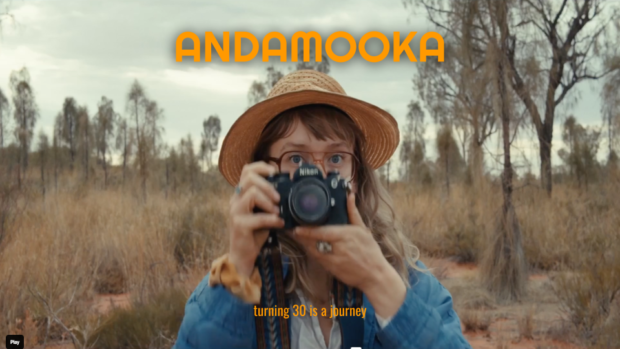Being an Aussie stuck thousands of miles away from home, I’m always excited to discover music, films, tv shows, literature and art from Down Under, thanks to YouTube, Vimeo and other platforms. After my two-month odyssey trekking around the outback and the big cities last year, I’m even more passionate about arts and entertainment coming out of Australia. There’s a wealth of independent Australian films being made and, joy-of-joys, lots of women filmmakers with successful careers and being given the respect they are due. One such filmmaker is writer, director, producer and actor MARA JEAN QUINN (below), to whom I was introduced by my Brisbane mate, Marilyn C. Bromley.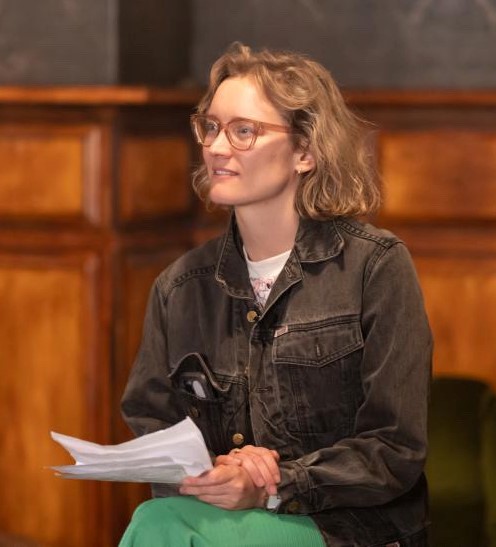 I dug around online and discovered what a multi-talented busy lady Mara Jean is! But like indie filmmakers around the world, the toughest part is finding the funding to complete the film and secure distribution – she is currently at that stage and is eager to find that last injection of $s to get her film Andamooka into cinemas.
I dug around online and discovered what a multi-talented busy lady Mara Jean is! But like indie filmmakers around the world, the toughest part is finding the funding to complete the film and secure distribution – she is currently at that stage and is eager to find that last injection of $s to get her film Andamooka into cinemas.
Andamooka is a feature-length road movie about a city woman whose life falls apart just before she turns 30. She goes to the outback on a quest to spend her birthday with her best friend in tiny opal mining town Andamooka. It paints an honest picture of womanhood, the pain of things not working out and the disconnected nature of city life. The film was shot on location in Western Queensland, Northern Territory & South Australia.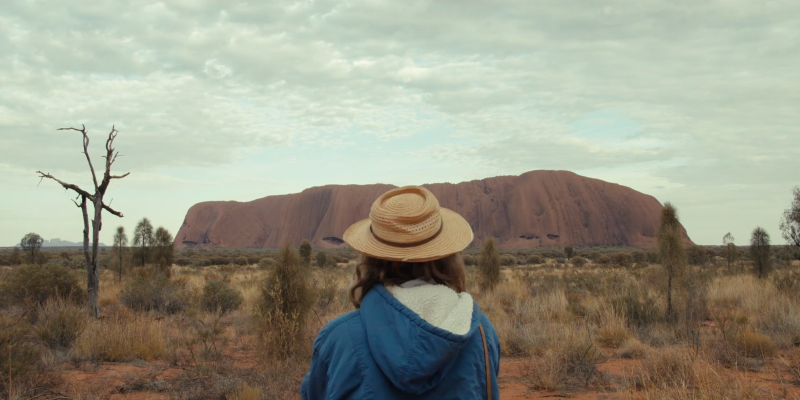 I recently asked Mara Jean to share stories from the set, how she got the film made, who helped her and, of course, the challenges of being an indie filmmaker in Australia…..
I recently asked Mara Jean to share stories from the set, how she got the film made, who helped her and, of course, the challenges of being an indie filmmaker in Australia…..
Mara Jean, you’ve had quite the career journey since starting in theatre in 1999, then as a film actor in 2006 as well as doing some modelling along the way. Since then, you’ve written, directed, produced…even worked in wardrobe. How have all these skills worked to your advantage now that you’re producing your own films? Having an understanding and interest in all the areas of the film means I have compassion and a basic grasp of what different departments are dealing with – this helps with communication and being able to really flavour the film. I think the most original work comes from sharing the weirdest and most honest parts of yourself. So if I can take a look at different areas of the film in an active way, I can colour the film and in the end like it more! In saying that I am very collaborative and love having input from other artists. Doing all these roles has been both an exploration of the medium and a necessity. Having to do difficult things out of pure necessity, I have realized I am capable of substantial output. I still go through moments of thinking things are too hard for me and impossible to achieve, but I chip away and get there in the end. I think everyone is far more capable than they believe!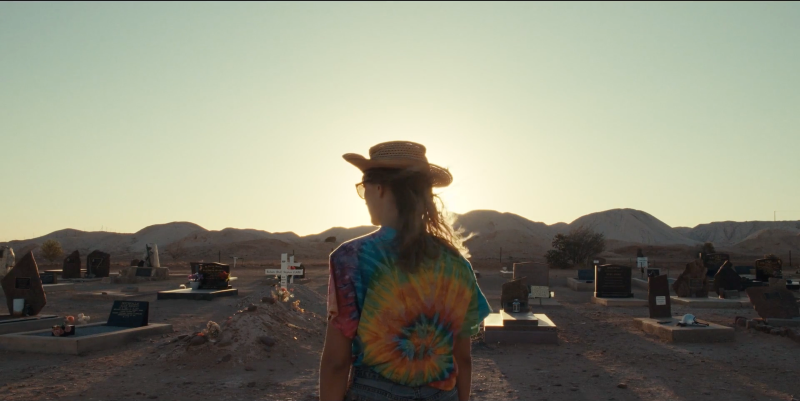 What inspired the story of Andamooka? It looks like a very personal and soul-searching journey from the city into the outback that you may have experienced yourself. I was in denial for ages that it wasn’t based on reality, but it is. I went through a tough time personally and I’d wanted to do an outback trip for years. Though, unlike the brave protagonist “Alex” I never wanted to do it alone. I did a number of solo trips in different parts of Australia and the world in my late teens to mid-20s, so I suppose this was a factor in writing a female lead solo journey film.
What inspired the story of Andamooka? It looks like a very personal and soul-searching journey from the city into the outback that you may have experienced yourself. I was in denial for ages that it wasn’t based on reality, but it is. I went through a tough time personally and I’d wanted to do an outback trip for years. Though, unlike the brave protagonist “Alex” I never wanted to do it alone. I did a number of solo trips in different parts of Australia and the world in my late teens to mid-20s, so I suppose this was a factor in writing a female lead solo journey film.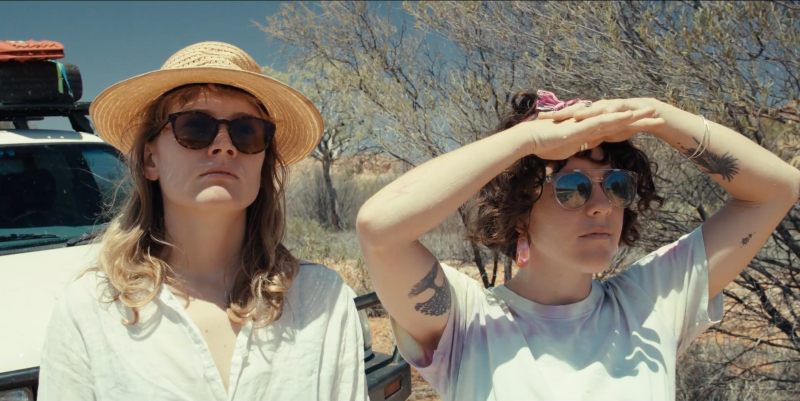 You spent a couple of months working with just a crew/cast of 3…talk about indie/guerilla movie-making. How the hell did you manage all that on such a tiny budget? I suppose it was treated like any sort of travel on a shoestring budget, the only difference was, we had a camera and a sound recorder and we shot scenes every second day or so. We were careful with our spending. We only paid for accommodation one night on the whole trip. That night we just really wanted walls, a roof and a washing machine! We free camped most of the time, as well as staying with different friends along the way. The hospitality we were met with was so heartwarming and the public facilities were great. The three of us have all been in the Arts for a long time, which unfortunately means we’re all used to living well below the poverty line. I think the sacrifices made to live a life of freedom and chasing dreams are worth it. The lucky thing also was that we were all in a place in our lives where we could step away and just hit the road for a few months without any income.
You spent a couple of months working with just a crew/cast of 3…talk about indie/guerilla movie-making. How the hell did you manage all that on such a tiny budget? I suppose it was treated like any sort of travel on a shoestring budget, the only difference was, we had a camera and a sound recorder and we shot scenes every second day or so. We were careful with our spending. We only paid for accommodation one night on the whole trip. That night we just really wanted walls, a roof and a washing machine! We free camped most of the time, as well as staying with different friends along the way. The hospitality we were met with was so heartwarming and the public facilities were great. The three of us have all been in the Arts for a long time, which unfortunately means we’re all used to living well below the poverty line. I think the sacrifices made to live a life of freedom and chasing dreams are worth it. The lucky thing also was that we were all in a place in our lives where we could step away and just hit the road for a few months without any income.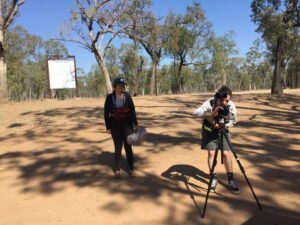
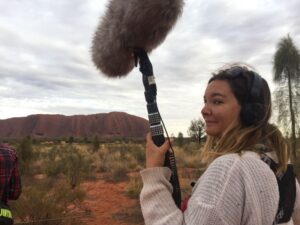 Were you given help and shelter by the locals as you travelled throughout Queensland, Northern Territory, NSW and South Australia? I understand you filmed on Traditional (Indigenous) lands – did that require specific sensitivities and/or were your “hosts” helpful and contributed to certain events in the script? We were met with incredible hospitality by everyone. We filmed five scenes with Indigenous Australians – all of these were written with the talent themselves. At the time of shooting, we got permission from some Traditional Owners to film on their sites, and since then we have gained retrospective permission to show all sites in the film. We had to remove some due to no-photography zones. The process of gaining permission to show sacred and non-sacred sites from the Traditional Owners has been mind opening and rewarding. We took the permissions to the next level gaining the blessings from the local people of all areas shown in the film, almost every shot! (Below, Sound Recordist Anthea Hilton and Director of Photography Danni Ogilvie on location)
Were you given help and shelter by the locals as you travelled throughout Queensland, Northern Territory, NSW and South Australia? I understand you filmed on Traditional (Indigenous) lands – did that require specific sensitivities and/or were your “hosts” helpful and contributed to certain events in the script? We were met with incredible hospitality by everyone. We filmed five scenes with Indigenous Australians – all of these were written with the talent themselves. At the time of shooting, we got permission from some Traditional Owners to film on their sites, and since then we have gained retrospective permission to show all sites in the film. We had to remove some due to no-photography zones. The process of gaining permission to show sacred and non-sacred sites from the Traditional Owners has been mind opening and rewarding. We took the permissions to the next level gaining the blessings from the local people of all areas shown in the film, almost every shot! (Below, Sound Recordist Anthea Hilton and Director of Photography Danni Ogilvie on location)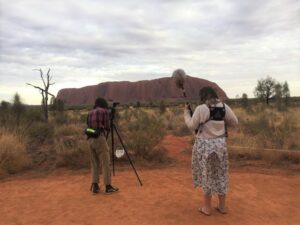 One of the greatest learnings early on in the trip was that Australia is actually made up of hundreds of nations all with their own languages and dialects, culture, art, song, knowledge, laws and protocols. We are essentially the United Nations of Australia! Seeing the Indigenous languages map (pictured below) gives a great visual to this perspective. This understanding was both inspiring and really devastating. Experiencing the depth and vitality of these cultures in the Outback made us reflect on what is often an absence of this culture on the East Coast. Living without the visibility of Aboriginal people or culture feels like living a lie, as though it never existed. It’s a hollow and unjust way to live, acting as though “Terra Nullius” was accurate. Being around different local languages and culture adds depth and understanding to a place, so on parts of the East Coast, where this is invisible, we are really missing out on a level of connection to country that has existed for over 60,000 years.I think we are in an exciting time in Australia where people are waking up, confronting truths about our ugly history. Aboriginal people are at the forefront in the Arts. People want to consume this art, and if they don’t, they just haven’t discovered the magic of it yet.
One of the greatest learnings early on in the trip was that Australia is actually made up of hundreds of nations all with their own languages and dialects, culture, art, song, knowledge, laws and protocols. We are essentially the United Nations of Australia! Seeing the Indigenous languages map (pictured below) gives a great visual to this perspective. This understanding was both inspiring and really devastating. Experiencing the depth and vitality of these cultures in the Outback made us reflect on what is often an absence of this culture on the East Coast. Living without the visibility of Aboriginal people or culture feels like living a lie, as though it never existed. It’s a hollow and unjust way to live, acting as though “Terra Nullius” was accurate. Being around different local languages and culture adds depth and understanding to a place, so on parts of the East Coast, where this is invisible, we are really missing out on a level of connection to country that has existed for over 60,000 years.I think we are in an exciting time in Australia where people are waking up, confronting truths about our ugly history. Aboriginal people are at the forefront in the Arts. People want to consume this art, and if they don’t, they just haven’t discovered the magic of it yet.
You recently acted in the zombie killer kangaroo feature film “The Red”…was this where you met your cultural advisor and producer, the brilliant Indigenous actor Aaron Pedersen? And how did you convince him to come on board with Andamooka? Yes! I first met Aaron on the phone when I was in the production team. We had great rapport straight away. I ended up auditioning for a role and acting alongside him and other amazing actors such as Terminator’s Michael Biehn. One day between takes, I told Aaron about my dormant project Andamooka, a pain in my heart, as it had sat untouched for over two years. It was a simple conversation and he took a look at the teaser. A few months later I was at my editor’s house in Sydney, just down the road from his place, and I realized I wanted him in the room. I wanted his take on the film and his input. I called him and asked if he’d like to come and see it, and if he liked then there was a role as a producer for him. I was nervous about how he would respond to the film and that he might have to let me down gently. Fortunately, he loved the film, jumped straight in, and was a great influence on the storytelling as well as many other hurdles in post. Aaron Pedersen (pictured below in the award-winning Mystery Road tv series) is not only a brilliant actor, but he’s an incredible story teller and human being. I bloody love Aaron and it is such an honour to work with him!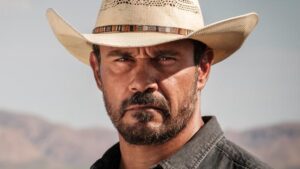 Funding is always a major issue when completing film and tv projects and I understand you self-financed filming. How difficult has it been raising $s to finish post-production of Andamooka? Have the various gov’t-run funding organizations assisted or are you hoping to remain completely independent from all the red-tape, relying strictly on private funding? It has been by far the most stressful, frustrating and restricting element. I did attempt to get government funding from a range of bodies, but because we had lots of volunteers on the film they cannot give us any funding. There is a huge gap in State and Federal government funding for indie films – most of the people I spoke to within these places are well aware of this and wish it wasn’t the case. Luckily one of the funding bodies wants to start supporting indie films and Andamooka has become a prototype for them. We’ve both been learning and figuring it out as we go. They have given us a small grant which has been really helpful. Initially in pre-production I did reach out to a few government agencies but was met with a lack of enthusiasm and pretty much flat out “no’s”. I don’t like pushing people to work with me. I have an enthusiasm requirement or I’m not interested. We have been lucky that some fantastic people have given in kind support as well as some deferred payment plans, such as Nicole Thorn who has done an amazing job editing the film, without her there’d be no film. We recently ran a fundraiser that resulted in AUD$11.5K raised, mostly from family and friends, so the team is super grateful to all those people. Amazing what a community can achieve when they rally to support the Arts.
Funding is always a major issue when completing film and tv projects and I understand you self-financed filming. How difficult has it been raising $s to finish post-production of Andamooka? Have the various gov’t-run funding organizations assisted or are you hoping to remain completely independent from all the red-tape, relying strictly on private funding? It has been by far the most stressful, frustrating and restricting element. I did attempt to get government funding from a range of bodies, but because we had lots of volunteers on the film they cannot give us any funding. There is a huge gap in State and Federal government funding for indie films – most of the people I spoke to within these places are well aware of this and wish it wasn’t the case. Luckily one of the funding bodies wants to start supporting indie films and Andamooka has become a prototype for them. We’ve both been learning and figuring it out as we go. They have given us a small grant which has been really helpful. Initially in pre-production I did reach out to a few government agencies but was met with a lack of enthusiasm and pretty much flat out “no’s”. I don’t like pushing people to work with me. I have an enthusiasm requirement or I’m not interested. We have been lucky that some fantastic people have given in kind support as well as some deferred payment plans, such as Nicole Thorn who has done an amazing job editing the film, without her there’d be no film. We recently ran a fundraiser that resulted in AUD$11.5K raised, mostly from family and friends, so the team is super grateful to all those people. Amazing what a community can achieve when they rally to support the Arts.
I am also extremely privileged to have generous parents: I was able to borrow money from them this year allowing me to work on this project full time for the last four months. Asking for help was an emotional process as I am usually proudly independent. I have had to get used to living in debt and carrying the stress of taking financial risks. I’ve also spent half the year sleeping on couches whilst working on the film in Sydney.
So how can film fans help? Please donate to our online fundraiser at https://artists.australianculturalfund.org.au/s/project/a2E9q000000EkNL
We are also looking for a distributor, a sales agent and all the things I am still learning about that make a film have a life!
And once completed, will you be submitting Andamooka to all the film fests around the world? What are the dream fests where you’d like to see your film showcased? We hope to tour world film festivals, have a selected cinematic release, and house the film on a streaming platform. And we hope to premiere at the inaugural SXSW Sydney in October this year. Andamooka is a universal story and almost everyone who has seen it has felt a strong connection, so the more people we can show, the more souls we will touch. It would be cool to end up in places like Toronto, Berlin, Mexico, New York, Indonesia, Japan and New Zealand.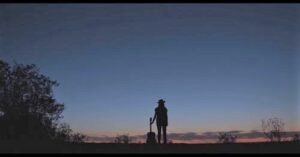 You can follow Mara Jean’s creative journey via: https://www.facebook.com/andamookafilm and instagram.com/andamookafilm
You can follow Mara Jean’s creative journey via: https://www.facebook.com/andamookafilm and instagram.com/andamookafilm
And thanks to DoP Danni Ogilvie for photos from the set.

